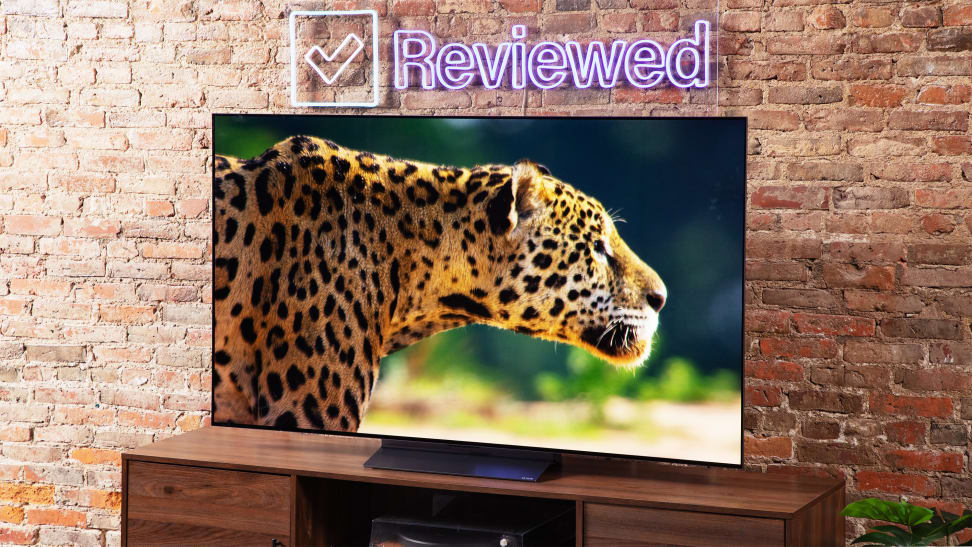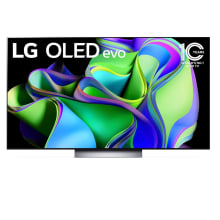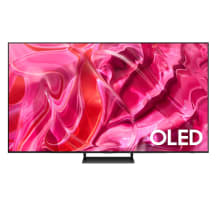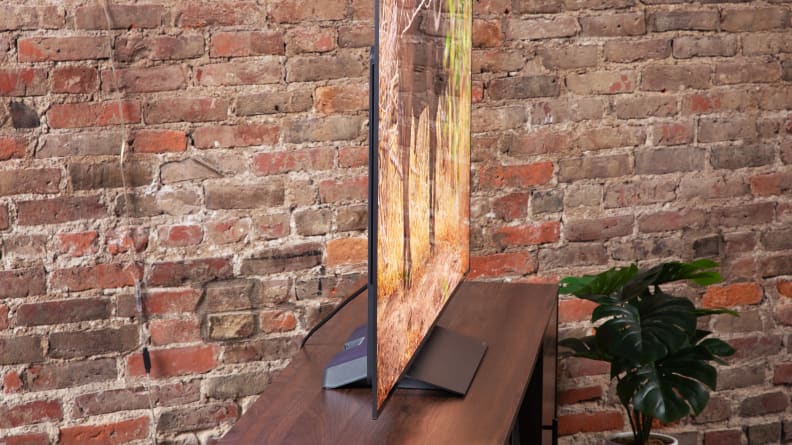LG C3 vs Samsung S90C: Which OLED is best?
Two of the most popular 2023 OLED TVs go head to head.
 Credit:
Reviewed / Timothy Renzi
Credit:
Reviewed / Timothy Renzi
Products are chosen independently by our editors. Purchases made through our links may earn us a commission.
If you’re in the market for a showstopper TV but you’d rather not ascend to the highest price tier, you ought to consider the LG C3 and the Samsung S90C. Both offer the advantages of OLED technology and the fancy features that come with high-end TVs, but without the sky-high asking price of a top-shelf flagship.
Although they share many of the same audio-, video-, and gaming-related features, the C3 and the S90C are quite different. When the dust settles, the C3 is a better choice for a broader swath of shoppers. That said, these are both seriously good TVs, so let’s break down both and figure out which is right for you.

With an incredible picture and full set of features, the LG C3 is the best TV for most people.

The Samsung S90C is the most affordable way to bring the QD-OLED experience to your living room.
LG C3 vs Samsung S90C: Price

Price wise, the LG C3 offers a better value for the six different sizes being offered.
Both of these TVs are seeing significant discounts in the months following their release. For full context, I’ll be listing both the MSRP and the sale price at the time of publishing.
LG C3:
- 42-inch (LG OLED42C3PUA), MSRP $1,399.99 (currently on sale for $896.99 at Amazon)
- 48-inch (LG OLED48C3PUA), MSRP $1,499.99 (currently on sale for $996.99 at Amazon)
- 55-inch (LG OLED55C3PUA), MSRP $1,899.99 (currently on sale for $1,296.99 at Amazon)
- 65-inch (LG OLED65C3PUA), MSRP $2,600 (currently on sale for $1,596.99 at Amazon)
- 77-inch (LG OLED77C3PUA), MSRP $3,599.99 (currently on sale for $1,996.99 at Amazon)
- 83-inch (LG OLED83C3PUA), MSRP $5,299.99 (currently on sale for $3,496.99 at Amazon)
Samsung S90C:
- 55-inch (Samsung QN55S90CAFXZA), MSRP $1,899.99 (currently on sale for $1,387.95 at Amazon)
- 65-inch (Samsung QN65S90CAFXZA), MSRP $2,599.99 (currently on sale for $1,597.99 at Amazon)
- 77-inch (Samsung QN77S90CAFXZA), MSRP $3,599.99 (currently on sale for $2,197.99 at Amazon)
- 83-inch (Samsung QN83S90CAEXZA), MSRP $5,399.99 (currently on sale for $2,997.99 at Amazon)
One important note about the S90C series: Samsung has confirmed that the 83-inch model uses a WOLED panel and not the QD-OLED found in the three smaller sizes. You can read more about the differences between these two technologies in our guide to QD-OLED, but for our purposes, the remainder of this head-to-head analysis will cover the 55-, 65-, and 77-inch models and their QD-OLED displays.
While the pricing of these series is similar, the C3 offers two smaller size options: 48- and 42-inch models. These are convenient for those with smaller living spaces, lower budgets, or for folks looking for an alternative monitor, and what wins the C3 the Price category.
Our pick: LG C3
LG C3 vs Samsung S90C: Design

Although the S90C and the LG C3 have a strikingly thin design, the C3's overall design is more aesthetically pleasing.
Due to their backlight-free nature, OLED TVs often take on stunningly thin profiles. At their thinnest, the C3 and S90C are about as narrow as a smartphone, with a thicker chassis attached around the midsection of the panel. From a design standpoint, their svelte proportions are what set them apart from even the thinnest LED TVs.
While both TVs are on the lighter side, the C3 is the lighter of the two, as it’s been constructed with lightweight, composite fiber material, while the S90C favors heavier plastic and metal components. Don’t equate the C3’s lightweight material with chintz, though; it feels sturdy and thoughtfully crafted.
Each model is equipped with a center-positioned stand. The C3’s wedge-shaped pedestal features an attractive brushed finish and minimizes wobble. The S90C’s stand, on the other hand, consists of a pair of feet that attach to a flat plate. I prefer the look and feel of the C3’s stand, but the S90C’s setup offers roughly an inch of additional clearance for soundbar placement.
The remote controls are worth mentioning, too. The S90C ships with Samsung’s Solar Cell remote control, which uses light and radio waves to charge its battery. The remote also features a USB-C port for emergency charging, and its battery level can be monitored within the TV’s settings menu. It’s a fantastically convenient feature that also cuts down on waste.
The C3 ships with LG’s Magic Remote, which offers optional, motion-activated controls that let you use it as a wand. Wiggling the remote activates an on-screen cursor that will track your hand movements.
The overall design of both TVs is respectable, but I find the C3’s presentation to be a bit more elegant. Both remote controls are equally praiseworthy, but the C3’s lightweight materials compliment its minimalist stand design, while the S90C’s stand is rather awkward-looking.
Our pick: LG C3
LG C3 vs Samsung S90C: Features and smart platform

Gamers will be impressed with the amount of features that both the S90C and C3 include.
Before we explore the many differences between these two OLED TVs, let’s take a look at the hardware- and software-related features they share.
- Resolution: 4K (3,840 x 2,160)
- HDR support: HDR10, HLG
- Dolby Atmos: Yes
- eARC support: Yes
- Color: DCI-P3 color space/10-bit chroma resolution
- Variable Refresh Rate (VRR): Yes
- Auto Low Latency Mode (ALLM): Yes
- Other features: Filmmaker Mode, Amazon Alexa, Google Assistant, Apple AirPlay, Apple Home
Let’s start in the A/V realm, where the biggest difference between each TV’s set of features has to do with HDR support. Of the two models, only the C3 supports Dolby Vision, a proprietary HDR format intended to present content in the manner closest to the creator’s intent. You can find Dolby Vision titles on streaming platforms like Netflix and Apple TV+, or on select 4K Blu-rays.
Like all Samsung TVs, the S90C doesn’t support Dolby Vision, and instead, supports a royalty-free standard called HDR10+. Like Dolby Vision, HDR10+ uses dynamic metadata to optimize content frame by frame. Most people won’t be able to tell the difference between the two enhanced formats, but Dolby Vision is nevertheless more popular.
In the gaming realm, the S90C has a leg up on the C3. Both TVs offer a full suite of HDMI 2.1 inputs capable of supporting 4K games at 120Hz, as well as Auto Low Latency Mode (ALLM) and Variable Refresh Rate (VRR). Make no mistake: Both of these TVs are a gamer’s dream.
However, for PC gaming, the S90C supports 4K content at 144Hz—better than the C3’s cap at 120Hz. The S90C also arrives with Samsung’s Gaming Hub, a software suite of cloud gaming services that lets you play games with nothing more than your favorite Bluetooth-enabled controller. Subscriptions are required for most of these cloud-based services, but casual and dedicated gamers alike will appreciate the option. The S90C’s strengths as a gaming TV and it’s relatively low cost (compared to higher-end OLED TVs) has earned it the top spot in our round-up of the best gaming TVs right now.
Finally, let’s talk about built-in smart platforms. LG’s webOS is considerably faster than it’s been in recent years, but the layout takes a while to familiarize oneself with, and it takes effort to navigate around the sponsored content. Samsung’s smart platform, while not quite as showy with its advertisements, is even harder to warm up to. Basic functions (like swapping inputs or pulling up various settings menus) feel like they take twice as many clicks as they ought to, and navigation is sluggish at times, too. I’d recommend pairing either TV with a dedicated streaming device, but if you can’t spare the HDMI port, I’d rather be stuck with webOS.
So, where does that leave us? Well, the C3 supports Dolby Vision and features a slightly better software experience. The S90C is a more-complete gaming package, but the elements that make it a more-complete package (144Hz capabilities and a cloud gaming suite) are somewhat esoteric. This one comes down to what you’re looking for.
Our pick: Draw
LG C3 vs Samsung S90C: Performance

The S90C delivers more brightness than the C3.
The C3 and S90C both offer the many benefits we’ve come to expect from OLED displays: perfect black levels with pixel-level dimming, rich, accurate color, and wider viewing angles than any LED TV in their price range. However, while you might not notice the difference unless both of these TVs were sitting side by side, the S90C does offer a handful of key benefits over its competitor.
Being a QD-OLED TV, the S90C has significant advantages over the C3 and its WOLED display. The color- and brightness-boosting properties of quantum dots allow the S90C to bypass the use of a color filter and white subpixel—two elements that the C3 relies upon.
Our lab results are unmistakable: The S90C features brighter specular highlights and more color volume than the C3. While both TVs offer comparable average picture brightness, the S90C can drive higher brightness to small areas of the picture (like a streetlight piercing through a night sky, or the reflection of sunlight off the hood of a car). For reference, with both TVs in Filmmaker Mode, a 10% white window on the C3 measures around 800 nits, while the very same window on the S90C clocks in at around 1,100 nits. That’s a sizable difference.
And, while both TVs deliver sensationally accurate color points in Filmmaker Mode right out of the box, the S90C saturates its colors more. Reds and greens tend to be much, much brighter on the S90C than the C3.
Both TVs are sensational performers and among the best TVs you can buy right now. Each brand’s picture processing is quite good, as well, so older, sub-4K content will hold up well. However, the S90C has an undeniable advantage when it comes to brightness and color volume.
Our pick: Samsung S90C
And the winner is…
The LG C3 is a better choice for most people than the Samsung S90C, but only by the slimmest of margins. The C3 offers more size options at similar price points, carries a slightly more attractive design, and while it lacks a couple of esoteric gaming features compared to the S90C, its Dolby Vision support has broader appeal.
That said, if you’re looking for the TV with the best picture quality, it’s hard to deny the S90C’s superiority here. At the time of publishing, it’s the most affordable way to secure a QD-OLED TV, and the benefits of QD-OLED are quite apparent.
It’s certainly a close matchup, but when you’re done racking your brain about it, take solace in the fact that you’re going to end up with one of the best TVs on the market today.


